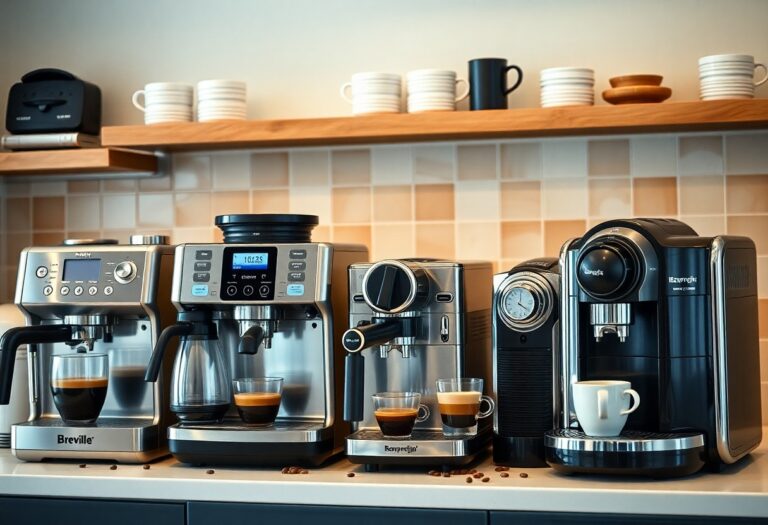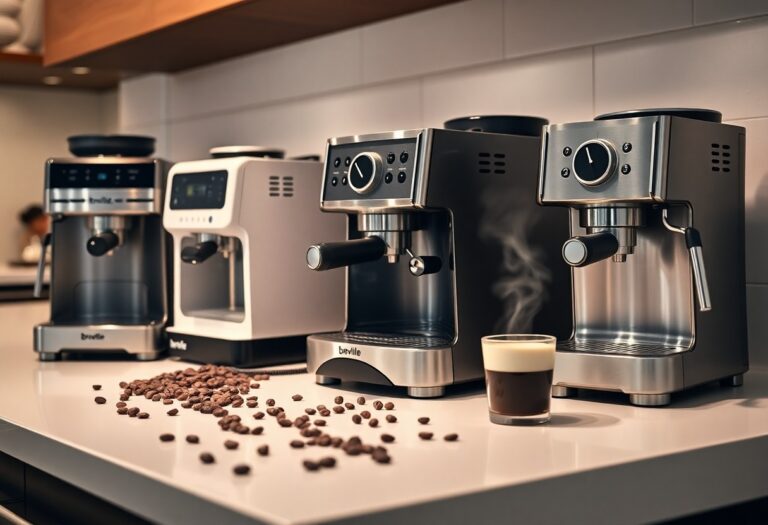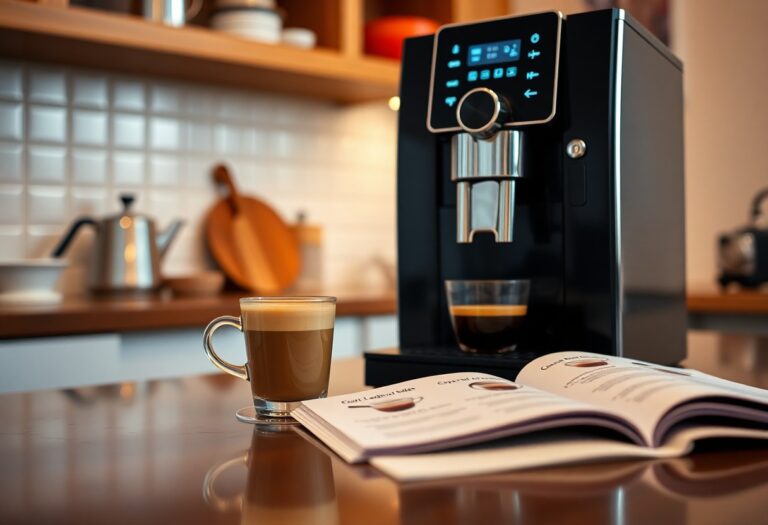What Coffee Do I Use for an Espresso Machine – Personal Selection
It’s vital to choose the right coffee for your espresso machine to elevate your brewing experience. You should look for freshly roasted beans that are specifically designed for espresso extraction, typically with a medium to dark roast profile. Beans with a rich flavor and balanced acidity will create a delightful shot, while blends or single origins can offer varying complexities. Pay attention to the grind size as well, as it profoundly influences the extraction process. With the right choice, you can transform your espresso into a truly enjoyable experience.
Key Takeaways:
- Choose coffee beans specifically labeled for espresso to ensure optimal flavor extraction.
- Look for medium to dark roasts, as they tend to provide a richer taste and better crema.
- Fine grind is important for espresso; ensure your coffee grinder can achieve this consistency.
- Consider single-origin beans for unique flavor profiles or blends for a balanced taste.
- Freshness matters; using coffee that has been roasted recently will enhance your espresso experience.
Unpacking Espresso Roast Profiles
Understanding the roast profiles of coffee beans is key to mastering your espresso machine. Each profile reveals unique characteristics that can drastically alter your coffee experience. Espresso typically shines when brewed with blends that cater to specific flavor notes and textures, enhancing the overall shot quality. From fruity and floral to rich and chocolatey, the nuances found in roast profiles can elevate your espresso from mundane to extraordinary.
Light, Medium, and Dark Roasts Explained
Roast levels significantly impact the taste and aroma of your coffee. Light roasts retain more of the beans’ natural flavors and acidity, often displaying fruity or floral notes. Medium roasts strike a balance, offering a well-rounded flavor with moderate acidity and sweetness. Dark roasts, on the other hand, exude bold, smoky profiles with deep caramelization but can sometimes overshadow subtle flavors.
How Roast Levels Affect Flavor and Body
The level of roast directly influences both the flavor profile and body of your espresso. Generally, light roasts deliver a more complex, vibrant taste and lighter body, perfect for highlighting unique attributes of the bean. Medium roasts provide a satisfying balance, rich in flavor while still offering a fuller body that pairs well with milk. Dark roasts evolve into an intense, bold espresso shot but can lack the brightness of lighter roasts, exhibiting a heavier mouthfeel that many espresso aficionados appreciate for its robustness.
As you experiment with different roast levels, pay attention to how each type changes the overall experience of your espresso. For example, a light roast brewed at the right temperature can reveal delicate fruity notes, while a medium roast will provide a sweet, chocolatey base. Conversely, a dark roast may dominate with bitter, robust flavors that create a substantial body. Personal preference plays a key role, so don’t hesitate to try various beans until you discover what resonates with your taste buds.
The Bean Origin Influence
The origin of your coffee beans significantly shapes the flavor and aroma profile of your espresso. Different regions produce beans with distinct characteristics, influenced by factors such as altitude, climate, and soil composition. High-altitude beans, for instance, often result in a brighter acidity and more complex flavors. As you explore various origins, you’ll notice how these elements contribute to the overall taste experience, allowing you to tailor your espresso to match your preferences.
Single-Origin vs. Blends: Finding Your Flavor Balance
Deciding between single-origin and blends comes down to the flavors you wish to explore. Single-origin coffees offer a unique taste that reflects the specific growing region, highlighting individual characteristics such as fruitiness or nuttiness. In contrast, blends combine beans from different origins, creating a balanced profile that can enhance body and sweetness. Experimenting with both options will help you uncover your ideal espresso flavor profile.
Regional Flavor Notes: What to Expect from Different Countries
Each coffee-producing country imparts unique flavor notes to its beans, making the origin a key factor in your espresso choices. For example, beans from Ethiopia are typically floral and fruity, while Colombian coffee often showcases a creamy body with nutty undertones. Brazilian coffees frequently present a chocolatey profile, while Sumatran beans can deliver earthy and spicy notes. By understanding these regional flavors, you can better select beans that align with your taste preferences.
When choosing your coffee, explore into the specific flavor profiles associated with each country. Ethiopian sidamo brings vibrant berry notes, making it an excellent choice for those who enjoy brighter flavors, while Guatemalan beans might surprise you with their rich chocolate and caramel tones. If you appreciate a smooth, full-bodied espresso, look towards Costa Rican or Colombian options. Ultimately, tasting coffees from diverse origins allows you to discover a spectrum of flavors, guiding you to your perfect espresso experience.

Grind Size and Its Impact on Extraction
Understanding grind size is vital for espresso preparation as it directly affects the extraction process. A finer grind increases the surface area of the coffee, allowing for more flavor compounds to be extracted quickly during the brewing process. Conversely, a coarser grind results in under-extraction, producing a weak and sour cup. Aim for the right balance to achieve the rich, full-bodied flavor that characterizes a perfect espresso.
Why Consistency Matters for Espresso
Consistency in grind size is important for achieving a reliable extraction each time you brew. If your grind varies, it leads to uneven extraction, producing a variety of flavors in your espresso shot—some bitter and others sour. This inconsistency can stem from using a blade grinder rather than a burr grinder, which provides a uniform grind important for the balance of flavors you desire.
The Perfect Range: Finding the Ideal Grind Size
Finding the ideal grind size involves experimenting within a specific range, typically between fine and super-fine. A good starting point is a grind similar to granulated sugar. From there, you can adjust based on your machine’s performance and your taste preferences, aiming for a shot time between 25 to 30 seconds for optimal flavor.
To narrow down your grind size effectively, begin with a consistent setting on your burr grinder and pull a shot within the targeted time frame. If your espresso extracts too quickly, switch to a finer grind and vice versa for slow extraction. Tasting adjustments after each change will help refine your process. Aim to maintain that 25-30 second extraction window as a golden standard, allowing a rich, balanced shot that showcases your chosen coffee’s unique qualities. Through practice and patience, you’ll develop the skill to pinpoint the grind size that brings out the best in your beans.

Personal Taste and Preferences
Your choice of coffee for an espresso machine boils down to your taste and how you enjoy your coffee experience. Whether you prefer a rich, velvety shot or something bright with fruity notes, your personal preference dictates the beans you select. Espresso blends often feature a combination of flavor profiles, from nutty and chocolatey to floral and acidic. Experimenting with different roasts will help you discover what tantalizes your taste buds the most.
How to Experiment with Different Beans
Keeping a Coffee Journal: Tracking Your Flavor Journey
Maintaining a coffee journal helps you document your flavor experiences and preferences over time. Jot down the name of the beans, roast type, and tasting notes after each brewing session. This practice not only aids in recognizing patterns in what you enjoy but also encourages you to revisit specific beans that stood out. As your palate evolves, so too will your appreciation for the complex world of coffee.
In your coffee journal, include specific descriptors for aroma, taste, acidity, and body to create a comprehensive profile of each brew. This process encourages mindfulness about what you savor and allows for better comparisons as you continue to explore different beans. Note any changes in your preferences or discoveries, such as a newfound love for a medium roast that once didn’t appeal to you. Documenting these details turns your coffee journey into a personalized flavor adventure, helping you refine your espresso choices over time.
Recommendations from Baristas and Experts
Baristas and coffee experts often recommend experimenting with specific blends tailored for espresso to achieve optimal flavor. While many coffee types can suit espresso-making, the consensus is that you should choose beans with a balanced acidity and richness. Check out this thread for insights from the community on Can any coffee be made as espresso? The prevailing favorites are medium to dark roasts, which can stand up to the brewing process while delivering a delightful crema.
Highlighted Coffee Brands Worth Trying
Some brands deliver specialty blends specifically crafted for espresso lovers. Look out for Counter Culture Coffee, which offers a variety of options with rich flavors, or Intelligentsia, known for its unique flavor profiles. Lavazza, an Italian staple, is also great when you crave a classic espresso experience. Try these brands to enhance your home brewing journey!
Tips for Sourcing Fresh Beans
Always buy freshly roasted beans from reputable sources to elevate your espresso game. Consider local coffee shops or roasters instead of chain stores to find high-quality options. Look for roast dates on packages and aim to use your beans within a month of roasting for the best flavor. Any delay can impact the intensity and freshness of your espresso.
- Choose locally roasted coffees for freshness.
- Check for roast dates to ensure quality.
- Try small batches to experience different flavors.
- Store your beans properly in an airtight container.
- Always buy in moderation to maintain freshness.
Incorporating these strategies will assist you in finding the best beans for your espresso machine. Look for small-batch roasters who emphasize quality and sustainability. Building a relationship with a reliable coffee provider can deepen your appreciation for the nuances in flavor and aroma. Any approach that prioritizes freshness will serve your espresso needs well.
- Seek out recommendations from professionals in the industry.
- Consider subscribing to a coffee delivery service for convenience.
- Connect with other coffee enthusiasts in your area.
- Remember to ask about brewing methods for personalized suggestions.
- Any willingness to experiment can lead to exciting discoveries.
Summing up
With these considerations in mind, you can confidently select the right coffee for your espresso machine. Your choice of beans significantly influences the flavor, strength, and overall quality of your espresso. Opt for a medium to dark roast for optimal results and explore various blends to find what suits your taste best. For further guidance, check out this article on How to Choose the Right Coffee Beans for Your Espresso … to enhance your coffee experience.
FAQ
Q: What type of coffee beans should I use for my espresso machine?
A: For an espresso machine, espresso roast coffee beans are ideal. These beans are typically a dark roast, which helps achieve that rich, bold flavor characteristic of espresso. However, you can also experiment with medium roasts if you prefer a slightly lighter taste, as many specialty roasters offer unique blends that enhance the espresso experience.
Q: Are single-origin coffees suitable for espresso?
A: Yes, single-origin coffees can be excellent for espresso, offering distinct flavors from specific regions or farms. Opt for beans from regions known for their espresso, like Latin America or Ethiopia. However, be aware that single-origin coffees may have taste profiles that differ from traditional espresso blends, giving you an opportunity to try something unique.
Q: Should I grind the coffee beans specifically for espresso?
A: Absolutely, grinding your coffee beans specifically for espresso is important. The grind size must be fine, similar to table salt, to ensure optimal extraction during the brewing process. An espresso machine requires this finer grind to create the proper pressure and flavor extraction. Investing in a good burr grinder can significantly improve the espresso quality.
Q: How fresh should the coffee beans be for espresso?
A: Freshness is vital when brewing espresso. Ideally, use coffee beans that were roasted within the past two to four weeks for the best flavor. Coffee beans start losing their freshness soon after roasting, so look for high-quality beans, and store them in an airtight container away from light and heat to preserve their freshness.
Q: Do I need to buy coffee specifically labeled for espresso?
A: While coffee labeled specifically for espresso can be a good choice, it is not a requirement. Any coffee that you enjoy can be used for espresso, as long as it is ground appropriately. Look for blends or roast profiles that appeal to your taste. Experimenting with different types of coffee can lead to discovering a custom espresso that suits your palate perfectly.







